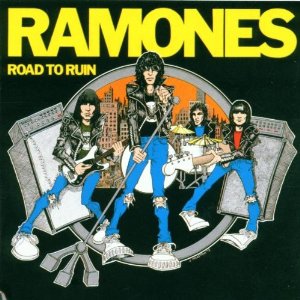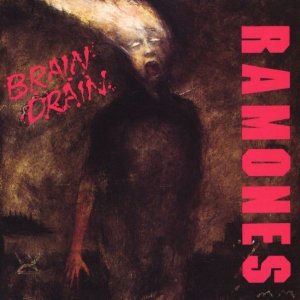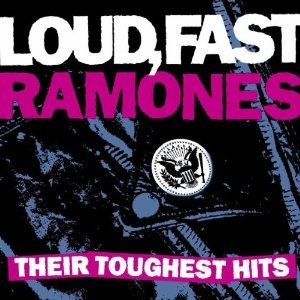| "Teenage Lobotomy" | |
|---|---|
| Song by Ramones | |
| from the album Rocket to Russia | |
| Released | November 1977 |
| Recorded | August-October 1977 |
| Genre | Punk rock |
| Length | 2:00 |
| Label | Sire/Philips |
| Songwriter(s) | Ramones |
| Producer(s) | Tony Bongiovi, Tommy Ramone |
"Teenage Lobotomy" is a song by the American punk rock band Ramones. It was released on their 1977 album Rocket to Russia , and became one of their most popular songs.
Punk rock is a rock music genre that emerged in the mid-1970s in the United States, United Kingdom, and Australia. Rooted in 1960s garage rock and other forms of what is now known as "proto-punk" music, punk rock bands rejected perceived excesses of mainstream 1970s rock. They typically produced short, fast-paced songs with hard-edged melodies and singing styles, stripped-down instrumentation, and often political, anti-establishment lyrics. Punk embraces a DIY ethic; many bands self-produce recordings and distribute them through independent record labels and other informal channels.

The Ramones were an American punk rock band that formed in the New York City neighborhood of Forest Hills, Queens, in 1974. They are often cited as the first true punk rock group. Despite achieving only limited commercial success initially, the band was highly influential in the United States and the United Kingdom.

Rocket to Russia is the third studio album by the American punk rock band the Ramones, and was released on November 4, 1977, through Sire Records. Its origins date back to the summer of 1977, when "Sheena Is a Punk Rocker" was released as a single. That summer was known as the peak of the punk rock genre since many punk bands were offered recording contracts. The album's recording began in August 1977, and the band had a considerably larger budget with Sire allowing them $25,000 and $30,000; much of this money went toward the album's production rather than recording.
Contents
The song's lyrics are about a teenager who had a lobotomy because of the brain damage caused by overexposure to DDT. The lyrics also outline how this procedure can cause serious consequences to the brain, with the line "Gonna get my Ph.D, I'm a teenage lobotomy." [1] The composition features more complex melodies than that of other songs from the album, with the album's engineer Ed Stasium proclaiming it to be a "mini-Ramones Symphony". [2]

A lobotomy, or leucotomy, is a form of psychosurgery, a neurosurgical treatment of a mental disorder that involves severing connections in the brain's prefrontal cortex. Most of the connections to and from the prefrontal cortex, the anterior part of the frontal lobes of the brain are severed. It was used for psychiatric and occasionally other conditions as a mainstream procedure in some Western countries for more than two decades. This was despite general recognition of frequent and serious side effects. While some people experienced symptomatic improvement with the operation, the improvements were achieved at the cost of creating other impairments. The procedure was controversial from its initial use in part due to the balance between benefits and risks. Today, lobotomy has become a disparaged procedure, a byword for medical barbarism and an exemplary instance of the medical trampling of patients' rights.

Dichlorodiphenyltrichloroethane, commonly known as DDT, is a colorless, tasteless, and almost odorless crystalline chemical compound, an organochlorine, originally developed as an insecticide, and ultimately becoming infamous for its environmental impacts. It was first synthesized in 1874 by the Austrian chemist Othmar Zeidler. DDT's insecticidal action was discovered by the Swiss chemist Paul Hermann Müller in 1939. DDT was used in the second half of World War II to control malaria and typhus among civilians and troops. Müller was awarded the Nobel Prize in Physiology or Medicine "for his discovery of the high efficiency of DDT as a contact poison against several arthropods" in 1948.

Ed Stasium is an American record producer and engineer who has worked on albums by the Ramones, Talking Heads, Motorhead, the Smithereens and Living Colour.
"Teenage Lobotomy" has been released as downloadable content for the music video game Rock Band .

A music video game, also commonly known as a music game, is a video game where the gameplay is meaningfully and often almost entirely oriented around the player's interactions with a musical score or individual songs. Music video games may take a variety of forms and are often grouped with puzzle games due to their common use of "rhythmically generated puzzles".

Rock Band is a series of music video games developed by Harmonix and MTV Games, and distributed by Electronic Arts for the Nintendo DS, iOS, PlayStation 2, PlayStation 3, PlayStation 4, PSP, Wii, Xbox One and Xbox 360 game systems. The series, inspired by Harmonix's previous efforts on the Guitar Hero series, allows up to four players to simulate the performance of popular rock music songs by playing with controllers modeled after musical instruments. Players can play the lead guitar, bass guitar, keyboard, and drums parts to songs, as well as sing into a USB microphone. Players are scored on their ability to match scrolling musical notes while playing instruments, and by their ability to match the singer's pitch on vocals.

















